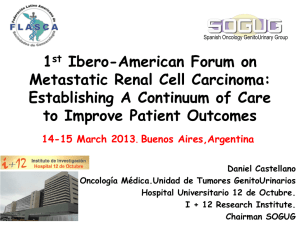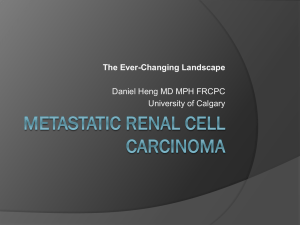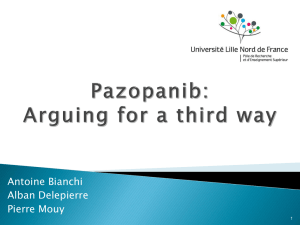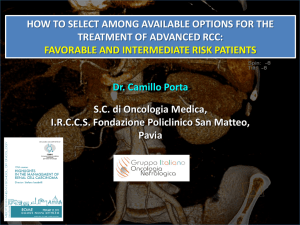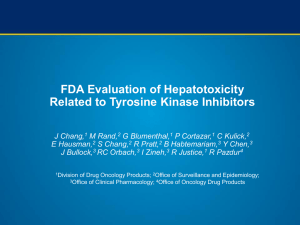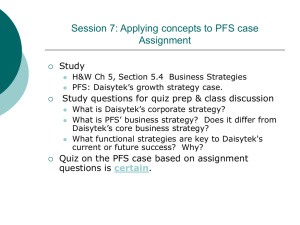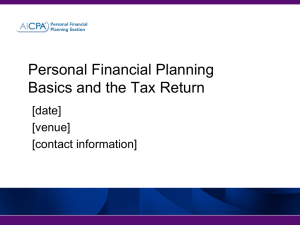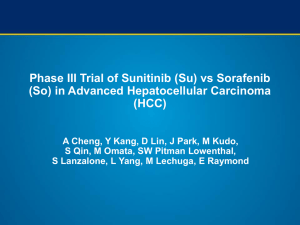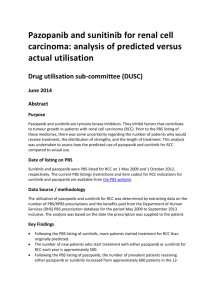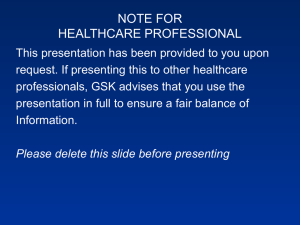Sorafenib
advertisement
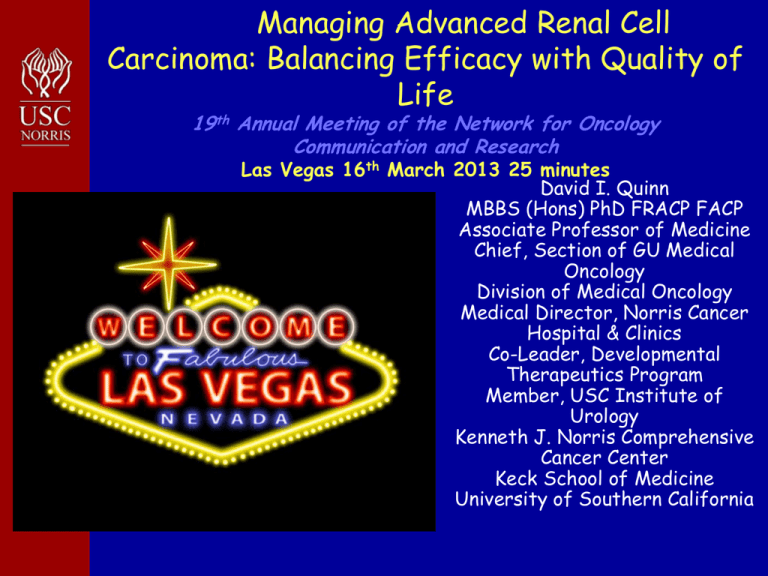
Managing Advanced Renal Cell Carcinoma: Balancing Efficacy with Quality of Life 19th Annual Meeting of the Network for Oncology Communication and Research Las Vegas 16th March 2013 25 minutes David I. Quinn MBBS (Hons) PhD FRACP FACP Associate Professor of Medicine Chief, Section of GU Medical Oncology Division of Medical Oncology Medical Director, Norris Cancer Hospital & Clinics Co-Leader, Developmental Therapeutics Program Member, USC Institute of Urology Kenneth J. Norris Comprehensive Cancer Center Keck School of Medicine University of Southern California Objectives – Cover the following clinical issues • Choosing a frontline agent • Selecting an agent for relapsed disease • Who are candidates for immunotherapy? Survival Rates by MSKCC Risk Factor Model 0 risk factors (n = 80 patients) 1 or 2 risk factors (n = 269 patients) 3, 4, or 5 risk factors (n = 88 patients) 1.0 0.9 Proportion surviving 0.8 Median survival 30 months 14 months 5 months Risk factors associated with worse prognosis 0.7 • KPS <80 0.6 • Low serum haemoglobin (13 g/dL/11.5 g/dL: M/F) 0.5 • High corrected calcium (10 mg/dL) 0.4 • High LDH (300 U/L) 0.3 • Time from diagnosis to IFN- <1 year 0.2 0.1 0 0 1 2 3 4 5 6 7 8 9 10 11 12 13 14 15 16 Time from start of IFN- (years) MSKCC = Memorial Sloan-Kettering Cancer Center; KPS = Karnofsky Performance Status Motzer RJ, et al. J Clin Oncol. 2002;20:289-296. Pathogenesis of RCC Endothelial cell EGF IGF-1 IGF-1R EGFR HER2 VEGF VEGFR Tumor cell FGFs RAS IL-8 RAF Dll4/Notch PTEN HGF/c-MET TSC1/2 MEK ERK Growth and proliferatio n VHL gene inactivated mTOR Metabolism HIF1a accumulation PDGFR PDGF Angiopoietin, epinephrine Angiogenic factors Angiogenesis FGF = fibroblast growth factor; IL-8 = interleukin 8; HGF = hepatocyte growth factor; Dll4 = delta-like ligand 4; EGF = epidermal growth factor; IGF = insulin-like growth factor; VEGF = vascular endothelial growth factor; PDGF = platelet-derived growth factor. 1. Ellis LM, et al. Clin Cancer Res. 2008;14:6371-6375; 2. Sjolund J, et al. J Clin Invest. 2008;118:217-228; 3. Huang D, et al. Cancer Res. 2010;1063-1071. Figure adapted from: Rini BI, Atkins MB. Lancet Oncol. 2009;10:992-1000. Pathogenesis of RCC Endothelial cell EGF IGF-1 EGFR IGF-1R HER2 VEGF VEGFR Tumor cell FGFs RAS IL-8 RAF PTEN Activation of AKT and mTOR MEK ERK Dll4/Notch PTEN inactivated HGF/c-MET PDGF TSC1/2 Angiopoietin, epinephrine mTOR mTOR Cell cycle entry Growth and Growth and proliferatio proliferation n Metabolism Metabolism PDGFR HIF1a accumulation Angiogenic factors Angiogenesis Angiogenesis FGF = fibroblast growth factor; IL-8 = interleukin 8; HGF = hepatocyte growth factor; Dll4 = delta-like ligand 4; EGF = epidermal growth factor; IGF = insulin-like growth factor; VEGF = vascular endothelial growth factor; PDGF = platelet-derived growth factor. 1. Ellis LM, et al. Clin Cancer Res. 2008;14:6371-6375; 2. Sjolund J, et al. J Clin Invest. 2008;118:217-228; Treatment options for RCC have been revolutionized in a short period of time… Bevacizumab + IFN5,6 Everolimus7 High dose interleukin-21 Temsirolimus4 Sorafenib2 Sunitinib3 Pazopanib8 Axitinib9 Tivozanib Dovitinib? 1992-2005 Interferon- 2005 2006 2007 2008 2009 2010 2012 ...but this rapid change has left many unanswered questions, including the optimal sequence of therapy 1. Fyfe G et al. J Clin Oncol 13:688-696, 1995 2. Escudier B et al. N Engl J Med 356:125-134,2007 3. Motzer RJ et al. N Engl J Med 356:115-124,2007 4. Hudes G et al. N Engl J Med 356:2271-2281 2007 5. Escudier B et al. Lancet 370:2103-211, 2007 6. Rini BI et al. J Clin Oncol 33:5422-8, 2008 7. Motzer RJ et al. Lancet 372:449-456, 2008 8. Sternberg CN et al. J Clin Oncol 28: 1061-8, 2010 9. Rini BI et al ASCO 2011 Objectives – Cover the following clinical issues • Choosing a frontline agent • Selecting an agent for relapsed disease • Who are candidates for immunotherapy? Advances in PFS in RCC: First-line Select Trial Results Since ASCO 2005: Median PFS 5.3 INF+IL-2+5-FU [Gore 2008] INF-α+ IL-2+5-FU2 Temsirolimus [PI] Temsirolimus3* Sorafenib4* Bevacizumab + INF-α5 5.5 Escudier [2009] 5.7 IFN 5.4 2005-Present 10.2 Bevacizumab + INF-α [Escudier 2008] IFN Bevacizumab + INF-α6 5.2 8.5 Bev + INF-α [Rini 2009]] IFN Sunitinib7* 5 11.0 Sunitinib [Motzer JCO 2009] 2.8 Placebo Pazopanib8* 11.1 Pazopanib [Sternberg 2010] 9.1 Placebo Sorafenib Tivozanib vs. Sorafenib9* 12.7 Tivozanib [Motzer ASCO 2012] 14.5 Axitinib [Rini ASCO 2012] Axitinib10 Time (months) 3-5 Multiple studies INF-α alone1 0 1 2 3 4 5 6 7 1. Kane et al. Clin Cancer Res. 2006;12:7271. 2. Gore et al. ASCO; 2008. Abstract 5039. 4. Escudier et al. J Clin Oncol. 2009;27:1280-9. 5. Escudier ASCO; 2008. Abstract 5025. 7. Motzer. J Clin Oncol. 2009;27:3584-90 8. Sternberg et al. J Clin Oncol.2010;28: 1061-8. 8 9 10 11 12 13 3. Torisel PI 6. Rini et al. J Clin Oncol 2008;26: 5422-8 * Central Review RCC Treatment Algorithm: 2013 Patients Therapy Other Options Has anything changed for 2013? (level 1) (≥ level 2) Setting Untreated Previously treated Good or Intermediate risk Sunitinib Bevacizumab + IFN Pazopanib Tivozanib (?) Axitinib (?) Clinical trial HD IL-2 Sorafenib Axitinib Clinical trial Observation Poor risk Temsirolimus Clinical trial Sunitinib Clinical trial Cytokine Sorafenib Pazopanib Axitinib Tivozanib Clinical trial Sunitinib, Bevacizumab Clinical trial VEGF Everolimus Axitinib Clinical trial Everything Sorafenib Other VEGF TKIs mTORi Nil VEGFTKI ? Dovitinib *Adapted from M Atkins, ASCO 2006 & R Bukowski ASCO 2007; Rini B ASCO 2008 Original Article Sunitinib versus Interferon Alfa in Metastatic Renal-Cell Carcinoma Robert J. Motzer, M.D., Thomas E. Hutson, D.O., Pharm.D., Piotr Tomczak, M.D., M. Dror Michaelson, M.D., Ph.D., Ronald M. Bukowski, M.D., Olivier Rixe, M.D., Ph.D., Stéphane Oudard, M.D., Ph.D., Sylvie Negrier, M.D., Ph.D., Cezary Szczylik, M.D., Ph.D., Sindy T. Kim, B.S., Isan Chen, M.D., Paul W. Bycott, Dr.P.H., Charles M. Baum, M.D., Ph.D., and Robert A. Figlin, M.D. N Engl J Med Volume 356(2):115-124 January 11, 2007 Progression-Free Survival Progression Free Survival Probability (Independent Central Review) Sunitinib Median: 11 months (95% CI: 10–12) 1.0 0.9 0.8 0.7 PFS Doubled 0.6 0.5 IFNMedian: 5 months (95% CI: 4–6) 0.4 0.3 0.2 Hazard Ratio = 0.415 (95% CI: 0.320–0.539) P <0.000001 0.1 0 0 1 2 3 No. at Risk Sunitinib: 235 No. at Risk IFN-: 152 4 5 6 7 8 Time (Months) 90 42 9 32 18 10 11 12 13 14 2 0 Motzer RJ et al. New Engl J Med 356: 115-124, 2007. Final Overall Survival OS benefit Total Death Sunitinib 190 IFN- 200 Figlin R et al. , ASCO 2008, abstract #5024 12 Phase III Pazopanib Versus Placebo Advanced RCC S T R A T I F Y R A N D O M I Z E Pazopanib 800 mg qd n=290 Matching placebo n=145 2:1 • • • • Patients stratified for ECOG PS 0 vs 1, prior nephrectomy, treatment naïve (N=233) vs 1 cytokine failure (N=202) Primary endpoint: PFS (by independent review) Secondary endpoints: OS, ORR (by independent review), duration of response, safety, health-related QoL Patients had an option to receive pazopanib via an open-label study at progression Sternberg. ASCO. 2009 (abstr 5021). Pazopanib Versus Placebo in Overall Study Population: PFS and OS Interim Analysis Median PFS Pazopanib: 9.2 mos Placebo: 4.2 mos HR=0.46 (95% CI, 0.340.62) P<0.0000001 0.8 PFS Doubled 0.6 0.4 0.2 1.0 Pazopanib Placebo 0.0 0 5 48% of patients receiving placebo received pazopanib after PD 0.8 Proportion Surviving Proportion Progression Free 1.0 0.6 0.4 Median OS Pazopanib: 21.1 mos Placebo: 18.7 mos HR=0.73 (95% CI, 0.47-1.12) P=0.02 (1-sided) OS Improved but … 0.2 Pazopanib Placebo 0.0 10 15 Time (months) 20 Overall Study Population PFS 5 Treatment-Naïve Patients 10 15 Time (months) Cytokine Pretreated Pazopanib Placebo Pazopanib Placebo Pazopanib Placebo 9.2 4.2 11.2 2.8 7.4 4.2 HR=0.46; P<0.0001 ORR 0 30% 3% HR=0.40; P<0.0001 32% 4% HR=0.54; P<0.001 29% 3% P<0.001 mDOR <1 year O’Brien-Fleming boundary for futility/superiority: P=0.201/0.004 (1-sided). Sternberg. ASCO. 2009 (abstr 5021). Sternberg CN et al. J Clin Oncol. January 25, 2010 [Epub ahead of print]. 20 25 First-line therapy in RCC Intermediate Poor TKI or BV+IFN? mTOR or Sunitinib? Good TKI or HDIL2/cyt okine or BV+IFN? Randomized, Open Label, Phase III Trial of Pazopanib versus Sunitinib in First-line Treatment of Patients with Metastatic Renal Cell Carcinoma (mRCC): Results of the COMPARZ Trial Robert Motzer1, T. E. Hutson2, James Reeves3, Robert Hawkins4, Jun Guo5, Paul Nathan6, Michael Staehler7, Paul de Souza8, Jaime R. Merchan9, Kate Fife10, Jie Jin11, Robert Jones12, Hirotsugu Uemura13, Ugo De Giorgi14, Ulrika Harmenberg15, Jinwan Wang16, David Cella17, Lauren McCann18, Keith Deen18, and Toni K. Choueiri19 1Memorial Sloan Kettering Cancer Center, NY, NY, USA; 2Baylor Sammons Cancer Center/Texas Oncology, Dallas, TX, USA; 3Florida Cancer Specialists, Fort Myers, FL, USA; 4University of Manchester and The Christie Hospital, NHS Foundation Trust, Manchester, United Kingdom; 5 Renal Cancer and Melanoma Unit, Peking University Cancer Hospital, Beijing, China; 6Mount Vernon Hospital, Middlesex, United Kingdom;7 Department of Urology, Interdisciplinary Centre on Renal Tumors, University of Munich, Munich, Germany; 8University of Western Sydney School of Medicine, MMRG, CRG, Sydney, Australia; 9 University of Miami, Sylvester Cancer Center, Miami, FL, USA:10 Oncology Centre, Addenbrooke's Hospital, Cambridge, United Kingdom; 11 Peking University First Hospital, Beijing, China; 12Institute of Cancer Sciences University of Glasgow, Glasgow, United Kingdom;13 Department of Urology, Kinki University Faculty of Medicine, Osaka, Japan; 14IRCCS Istituto Scientifico Romagnolo per lo Studio e la Cura dei Tumori (I.R.S.T.), Meldola, Italy; 15Department of Oncology, Radiumhemmet Karolinska University Hospital, Stockholm, Sweden; 16 Cancer Hospital, CAMS & PUMC, Beijing, China; 17Robert H. Lurie Comprehensive Cancer Center of Northwestern University, Chicago, IL , USA; 18GlaxoSmithKline, Inc., Collegeville, PA, USA; 10Department of Medical Oncology, Dana-Farber Cancer Institute, Boston, MA, USA Study Objectives Primary • To evaluate and compare PFS in patients treated with pazopanib to those treated with sunitinib as initial systemic therapy Secondary • Overall survival (OS) • Objective response rate (ORR) • Safety • Patient-reported outcomes Study Design Pazopanib 800 mg qd continuous dosing Key Eligibility Criteria • • • • • • Advanced/metastatic RCC Clear-cell histology No prior systemic therapy Measurable disease (RECIST 1.0) KPS ≥ 70 Adequate organ function Dose reductions to 600 mg or 400 mg Randomized 1:1 Stratification Factors • KPS 70/80 vs 90/100 • Prior nephrectomy • Baseline LDH >1.5 vs ≤1.5×ULN Sunitinib 50 mg qd 4 wk on/2 wk off Dose reductions to 37.5 mg or 25 mg Primary Endpoint: Progression-free Survival (independent review) N Median PFS (95% CI) Pazopanib 557 8.4 mo (8.3, 10.9) Sunitinib 553 9.5 mo (8.3, 11.1) HR (95% CI ) = 1.047 (0.898,1.220) Pazopanib Sunitinib Best Response by RECIST 1.0 (independent review) Pazopanib (n = 557) Sunitinib (n = 553) Complete response (CR) Partial response (PR) Stable disease Progressive disease Not evaluable <1 31 39 17 13 <1 24 44 19 12 Objective Response Rate (CR +PR), % 31 25 26.9, 34.5 21.2, 28.4 Best overall response, % 95% CI P value 0.032 Interim Analysis of Overall Survival N Median OS (95% CI) Pazopanib 557 28.4 mos (26.2, 35.6) Sunitinib 553 29.3 mos (25.3, 32.5) HR (95% CI ) = 0.908 (0.762,1.082) P-value = 0.275 Pazopanib Sunitinib Treatment Duration and Dose Adjustments Pazopanib (n = 554) Sunitinib (n = 548) 8.0 (0−40) 7.6 (0−38) Dose reductions, % 44 51 Discontinuations due to AEs1, % 24 19 Median duration of treatment (months, range) 1. Most common reason: pazopanib arm (liver event, 6%); sunitinib arm (cytopenia, 3%) Most Common Adverse Events (treatment-emergent) Pazopanib (n = 554) % Sunitinib (n = 548) % Adverse Event 1 All Grades All Grades Any event 2 Diarrhea Fatigue Hypertension Nausea Decreased appetite ALT increased Hair color changes Hand-foot syndrome Taste alteration Thrombocytopenia >99 63 55 46 45 37 31 30 29 26 10 >99 57 63 41 46 37 18 10 50 36 34 1 AE ≥30% in either arm of patients in pazopanib arm and 3% of patients in sunitinib arm had grade 5 adverse events Yellow highlight: Risk greater for pazopanib and 95% CI for relative risk does not cross 1 2 2% Most Common Adverse Events (treatment-emergent) Adverse Event 1 Any event 2 Diarrhea Fatigue Hypertension Nausea Decreased appetite ALT increased Hair color changes Hand-foot syndrome Taste alteration Thrombocytopenia 1 AE Pazopanib (n = 554) % Sunitinib (n = 548) % All Grades All Grades >99 63 55 46 45 37 31 30 29 26 10 >99 57 63 41 46 37 18 10 50 36 34 ≥30% in either arm of patients in pazopanib arm and 3% of patients in sunitinib arm had grade 5 adverse events Blue Highlight: Risk greater for sunitinib and 95% CI for relative risk does not cross 1 2 2% Quality of Life Results (first 6 months1) Treatment difference : mean change from baseline 2 P -value Fatigue/Total score 2.32 <0.001 Kidney Symptom Index/Total score 1.41 0.018 Physical 0.78 0.027 Emotional 0.05 0.409 Treatment Side Effects 0.31 0.033 Functional Well Being 0.31 0.098 Expectations of Therapy 1.41 0.284 Feelings about Side Effects 8.50 <0.001 Satisfaction with Therapy 3.21 <0.001 Worst mouth/throat soreness 0.505 <0.0001 Worst foot soreness 0.204 0.0016 Worst hand soreness 0.267 0.0008 Limitations due to mouth/throat soreness 0.94 <0.001 Limitations due to foot soreness 0.65 0.014 Instrument FACIT-F FKSI-19 Cancer Treatment Satisfaction Questionnaire (CTSQ) Supplementary Quality of Life Questionnaire (SQLQ) 1Pre-specified Domain Description analysis. HRQoL changes in mean scores over time were analyzed with a repeated measures analysis of covariance (ANCOVA). 2Yellow Font: favors pazopanib. Blue Font: favors sunitinib. P-value <0.05 is statistically significant Quality of Life Results (first 6 months1) Treatment difference : mean change from baseline 2 P -value Fatigue/Total score 2.32 <0.001 Kidney Symptom Index/Total score 1.41 0.018 Physical 0.78 0.027 Emotional 0.05 0.409 Treatment Side Effects 0.31 0.033 Functional Well Being 0.31 0.098 Expectations of Therapy 1.41 0.284 Feelings about Side Effects 8.50 <0.001 Satisfaction with Therapy 3.21 <0.001 Worst mouth/throat soreness 0.505 <0.0001 Worst foot soreness 0.204 0.0016 Worst hand soreness 0.267 0.0008 Limitations due to mouth/throat soreness 0.94 <0.001 Limitations due to foot soreness 0.65 0.014 Instrument FACIT-F FKSI-19 Cancer Treatment Satisfaction Questionnaire (CTSQ) Supplementary Quality of Life Questionnaire (SQLQ) 1Pre-specified Domain Description analysis. HRQoL changes in mean scores over time were analyzed with a repeated measures analysis of covariance (ANCOVA). 2Yellow Font: favors pazopanib. Blue Font: favors sunitinib. P-value <0.05 is statistically significant Conclusions • This phase III trial demonstrates non-inferiority of pazopanib compared to sunitinib for progression-free survival • Pazopanib efficacy is further supported by similar response rates and overall survival • The differentiated safety profile of pazopanib includes: – Lower incidence of hand-foot syndrome, fatigue, and mucositis – Higher incidence of liver function test abnormalities and weight loss • Quality of life assessment favors pazopanib over sunitinib Same, Same but different? Take away points .. • Non-inferiority … is there a winner? • Less toxicity or different but with better QoL? • Impact in clinical practice? • Wither axitinib or tivozanib? Objectives – Cover the following clinical issues • Choosing a frontline agent • Selecting an agent for relapsed disease • Who are candidates for immunotherapy? a zen moment un momento del zen RECORD-1: Everolimus / BSC vs BSC: Study Design Everolimus + BSC mRCC Stratification by prior VEGFR TKI, MSKCC risk group1 Randomized 2:1 (double blind) everolimus: 10 mg po daily repeated 28-day cycle Upon disease progression Placebo + BSC Eligibility: Clear cell component; prior bevacizumab and cytokines permitted Matching placebo po daily repeated 28-day cycle Primary endpoint: PFS Secondary endpoints: Safety, response , patient-reported outcomes, and OS Motzer, et al. Lancet. 2008;372:449-456. Motzer, et al. J Clin Oncol. 2004;22:454-463. ORR % 1.0 vs 0.0 PFS mos 4.9 vs 1.9 (HR=0.33; P<0.001) OS mos 14.8 vs 14.4 (HR=0.87; P=0.177) Everolimus: Progression-Free Survival Central Radiology Review PFS Doubled Motzer, ESMO 2008, abstract 720 Axitinib versus sorafenib as secondline therapy for metastatic renal cell carcinoma (mRCC): Results of phase III AXIS trial Abstract 4503 B. I. Rini, B. Escudier, P. Tomczak, A. Kaprin, T. E. Hutson, C. Szczylik, J. C. Tarazi, B. Rosbrook, S. Kim, R. J. Motzer Cleveland Clinic Taussig Cancer Institute, Cleveland, OH; Institut Gustave Roussy, Villejuif, France; Klinika Onkologii, Oddzial Chemioterapii, Poznan, Poland; Russian Oncology Centre, Moscow, Russia; Baylor Sammons Cancer Center-Texas Oncology PA, Dallas, TX; Wojskowy Instytut Medyczny, CSK MON Klinika Onkologii, Warszawa, Poland; Pfizer Oncology, La Jolla, CA; Memorial Sloan-Kettering Cancer Center, New York, NY J Clin Oncol 29: 2011 (suppl; abstr 4503) AG-013736 (axitinib) vs. Sorafenib as Second-Line Therapy For Metastatic Renal Cell Cancer Patients after disease progression to one prior systemic first-line treatment (N=540) R A N D O M I Z A T I O N Axitinib 5 mg BID 1:1 Sorafenib (2x200 mg) BID Primary end point: Compare PFS of patients receiving AG-013736 versus sorafenib in mRCC after disease progression to one prior systemic first-line regimen containing one or more of the following agents: sunitinib, bevacizumab + IFN alfa, temsirolimus or cytokine(s). Secondary end point: OS, ORR, evaluate safety and tolerability, DR, compare symptoms’ severity AXIS: Randomized Phase III Trial, Axitinib vs Sorafenib in Refractory Metastatic RCC Progression-Free Survival (probability) • Primary endpoint: PFS 1.0 0.9 0.8 0.7 0.6 0.5 0.4 0.3 0.2 0.1 0.0 mPFS, mo Axitinib 6.7 Sorafenib 4.7 95% CI 6.3-8.6 4.6-5.6 • Treatments generally well tolerated; similar toxicity P < 0.0001 (log-rank) Stratified HR 0.665 (95% CI 0.544-0.812) 0 2 4 6 Subjects at risk, n Axitinib 361 256 202 145 Sorafenib 362 224 157 100 8 10 12 14 Time (months) 96 51 64 28 38 12 20 6 Rini BI, et al. ASCO 2011. Abstract 4503 16 10 3 18 20 1 1 0 0 – All-grade hypertension and hypothyroidism more common with axitinib – All-grade hand-foot syndrome, rash, and alopecia more common with sorafenib – Discontinuation due to treatment-related AEs: • 3.9% in axitinib group • 8.2% in sorafenib group PFS by Prior Regimen Prior Treatment Regimen Axitinib (n=361) Sorafenib (n=362) HR P value* Cytokines (n=251) IRC Investigator 12.1 12.0 6.5 8.3 0.464 0.636 <0.0001 0.005 Sunitinib (n=389) IRC Investigator 4.8 6.5 3.4 4.5 0.741 0.636 0.011 0.0002 Temsirolimus (n=24) IRC Investigator 10.1 2.6 5.3 5.7 0.511 1.210 0.142 0.634 Bevacizumab (n=59) IRC Investigator 4.2 6.5 4.7 4.5 1.147 0.753 0.637 0.213 *One-sided log-rank test stratified by ECOG PS ESMO 2012: Abstract No. 918 Temsirolimus vs Sorafenib as Second-Line Therapy in Metastatic Renal Cell Carcinoma: Results From the INTORSECT Trial T. E. Hutson,1 B. Escudier,2 E. Esteban,3 G.A. Bjarnason,4 H. Y. Lim,5 K. Pittman,6 P. Senico,7 A. Niethammer,8 D. Lu,8 S. Hariharan,9 R. Motzer10 1Baylor University Medical Center, Dallas, TX/UNITED STATES; 2Institut Gustave Roussy, Villejuif/FRANCE; 3Hospital Universitario Central de Asturias, Oviedo, Asturias/SPAIN; 4Odette Cancer Centre, Sunnybrook Health Sciences Centre, Toronto, Ontario/CANADA; 5Samsung Medical Center, Seoul/KOREA; 6The Queen Elizabeth Hospital, Woodville South, Adelaide/AUSTRALIA; 7Pfizer Inc, Collegeville, PA/UNITED STATES; 8Pfizer Inc, La Jolla, CA/UNITED STATES; 9Pfizer Inc, New York, NY/UNITED STATES; 10Dept, Memorial Sloan-Kettering Cancer Center, New York, NY/UNITED STATES INTORSECT* Study Design R Patients with mRCC and PD on 1st-line sunitinib (N=512) Stratification factors: •Duration of sunitinib therapy (≤ or >6 mo) •MSKCC risk group •Histology (clear cell or non–clear cell) •Nephrectomy status A N D Temsirolimus 25 mg IV weekly† (n=259) O M I Z E Sorafenib Primary end point: PFS (per IRC) 400 mg oral BID† (n=253) Treat until PD, unacceptable toxicity, or discontinuation for any other reason 1:1 *ClinicalTrials.gov Identifier: NCT00474786 †Dose reductions were allowed: temsirolimus (to 20 mg then 15 mg), sorafenib (to 400 mg/day then every other day). BID, twice daily; IRC, independent review committee; IV, intravenous; mRCC, metastatic renal cell carcinoma; MSKCC, Memorial Sloan-Kettering Cancer Center; PD, progressive disease; PFS, progression-free survival. 38 Study Objectives Primary objective ─ To compare safety and efficacy (PFS as determined by IRC) of temsirolimus and sorafenib in the 2nd-line setting for patients with mRCC after failure on prior sunitinib Secondary objectives – – – – PFS determined by investigator assessment Objective response rate Overall survival (OS) Proportion of patients with PFS at 12, 24, and 36 weeks – Duration of response IRC, independent review committee; mRCC, metastatic renal cell carcinoma; PFS, progression-free survival. 39 Statistical Methods Primary end point: PFS (assessed by blinded IRC) ─ 80% power to detect a 33% improvement in PFS with a stratified 2-sided log-rank test at 0.05 alpha level ─ Sample size of 480 patients required to observe 380 progression events with 15% drop-out rate ─ Analysis based on ITT population, compared using stratified log-rank test Secondary end point: OS IRC, independent review committee; ITT, intent to treat; OS, overall survival; PFS, progression-free survival; RCC, renal cell carcinoma. 40 Progression-Free Survival (IRC Assessment) Median PFS, 95% CI months 4.28 4.01, 5.43 Temsirolimus 3.91 2.80, 4.21 Sorafenib 1.0 PF S (probability) 0.9 0.8 P=0.1933 (log-rank) Stratified HR: 0.87 (95% CI: 0.71, 1.07) 0.7 0.6 0.5 0.4 0.3 0.2 0.1 0.0 0 5 15 20 25 6 5 0 0 Time (months) Patients at risk, n Sorafenib Temsirolimus 10 252 259 72 96 22 28 11 9 CI, confidence interval; HR, hazard ratio; IRC, Independent Review Committee; PFS, progression-free survival. 41 Objective Response by RECIST (IRC Assessment) Response Parameter, n (%) Overall confirmed ORR* Complete response Partial response Stable disease Progressive disease Median duration of response, months (95% CI) Temsirolimus (n=259) Sorafenib (n=253) 20 (8) 0 20 (8) 151 (61) 59 (23) 20 (8) 1 19 (8) 153 (61) 61 (24) 8.26 (6.71, 10.36) 6.96 (4.18, 17.50) *Stratified 1-sided Cochran-Mantel-Haenszel test of treatment. CI, confidence interval; IRC, independent review committee; ORR, objective response rate; RECIST, Response Evaluation Criteria in Solid Tumors. 42 Overall Survival Median OS, 95% CI months 12.27 10.13, 14.80 Temsirolimus 16.64 13.55, 18.72 Sorafenib Overall Survival (probability) 1.0 0.9 0.8 P=0.014 (log-rank) Stratified HR: 1.31 (95% CI: 1.05, 1.63) 0.7 0.6 0.5 0.4 0.3 0.2 0.1 0.0 0 10 30 40 50 13 8 0 0 Time (months) Patients at risk, n Sorafenib Temsirolimus 20 253 259 158 132 74 54 CI, confidence interval; HR, hazard ratio; OS, overall survival. 34 22 43 OS by Duration of Prior Sunitinib (ITT Population) Prior Sunitinib Use Temsirolimus (n=259) Sorafenib (n=253) HR (95% CI) ≤180 days, n (%) Median OS, mo (95% CI) 97 (38%) 10.1 (8.5, 13.4) 92 (36%) 11.4 (8.9, 16.8) 1.30 (0.94, 1.81) 0.111 >180 days, n (%) Median OS, mo (95% CI) 162 (62%) 14.4 (11.3, 16.9) 161 (64%) 17.8 (15.4, 22.9) 1.37 (1.04, 1.80) 0.025 P value* *Unstratified log-rank test. CI, confidence interval; HR, hazard ratio; ITT, intent to treat; OS, overall survival. 44 OS by Subgroup Subgroup N HR 95% CI All patients 511 1.31 1.05, 1.63 Prior nephrectomy 442 1.45 1.15, 1.82 No prior nephrectomy 70 0.84 0.49, 1.43 ≤180 days sunitinib therapy 189 1.30 0.94, 1.81 >180 days sunitinib therapy 323 1.37 1.04, 1.80 Clear cell histology 422 1.34 1.06, 1.69 Non–clear cell histology 90 1.42 0.86, 2.35 MSKCC favorable subgroup 94 0.95 0.55, 1.64 MSKCC intermediate subgroup 355 1.50* 1.17, 1.94 MSKCC poor subgroup 63 1.37 0.81, 2.32 0.1 Favors Temsirolimus 1 Favors Sorafenib 10 *P=0.002. CI, confidence interval; HR, hazard ratio; MSKCC, Memorial Sloan-Kettering Cancer Center; OS, overall survival. 45 Grade ≥3 Adverse Events* Temsirolimus (n=249) Sorafenib (n=252) All grades Grade 3/4 All grades Grade 3/4 Hand-foot syndrome 4 0 52 15 Fatigue 40 6 34 7 Anemia 34 9 14 3 Hypophosphatemia 11 5 12 7 Hyperglycemia 19 8 6 2 Diarrhea 31 2 63 6 Event, % *Incidence ≥5% in either treatment arm. 46 Conclusions Temsirolimus did not show superiority over sorafenib in the primary end point of PFS nor in the secondary end point of OS ─ Median PFS was slightly longer with temsirolimus compared to sorafenib (4.28 months vs. 3.91 months), but this difference was not statistically significant. ─ The sorafenib arm had longer median OS than the temsirolimus arm (16.64 months vs 12.27 months; P=0.014) Safety data were as expected for both agents Further evaluation is needed to define the optimal treatment sequence after prior sunitinib in patients with advanced RCC OS, overall survival; PFS, progression-free survival; RCC, renal cell carcinoma. 47 Discussion points, thoughts PFS vs. OS in RCC Temsirolimus is used in 30% of patients second line in USA Sequential therapy issues in question: VEGFrTKI vs. mTORi Real efficacy of sorafenib 48 Objectives – Cover the following clinical issues • Choosing a frontline agent • Selecting an agent for relapsed disease • Who are candidates for immunotherapy? High-Dose IL-2 Therapy: PLA Database: Response Durations in 255 Patients 1.0 CR (n = 17) PR (n = 20) CR + PR (n = 37) Probability of Continuing Response 0.9 0.8 0.7 0.6 0.5 0.4 0.3 0.2 0.1 0.0 0 80 10 90 20 100 30 110 40 50 60 Duration of Response (Months) Fisher et al. J Sci Am 1997 70 PD-1/PD-L1 Pathway: Tumor cells—T cells • PD-L1 can be expressed on tumor cells either endogenously or induced by association with T cells (adaptive immune resistance)1,2 • In RCC, PD-L1 expression has been shown to be associated with adverse clinical/pathologic features, including3: – More aggressive disease – Shorter survival 1. Topalian et al. Curr Opin Immunol. 2012. 2. Taube JM et al. Science Transl Med. 2012;4:127ra37. 3. Thompson RH et al. PNAS 2004. Anti-PD-1: Blocking T-cell Suppression1,2 1. Keir ME et al. Ann Rev Immunol. 2008. 2. Pardoll DM. Nat Rev Cancer. 2012. Clinical Activity of Nivolumab in RCC Patients1 All RCC Nivolumab dose ORR, n (%) DOR, mo SD ≥ 2 wk, n (%) 24-wk PFS, % RCC 1, 10 (n = 33) 1 (n = 17) 10 (n = 16) 9 (27) 4 (24) 5 (31)a 5.6+-22.3+ 5.6+-17.5+ 8.4-22.3+ 9 (27) 4 (24) 5 (31) 56 47 67 • ORR was assessed using modified RECIST v1.0 • 2 RCC patients had a persistent reduction in baseline target lesions in the presence of new lesions, but were not classified as responders for the ORR calculation a 1 CR. 1. McDermott DF et al. J Clin Oncol. 2012;30:Abstract 4505. Partial Regression of Metastatic RCC in a Patient Treated With 1 mg/kg Nivolumab1 Pretreatment 6 months • The 57-year-old patient had developed progressive disease after receiving sunitinib, temsirolimus, sorafenib, and pazopanib • Currently in cycle 6 with ongoing PR 1. McDermott DF et al. J Clin Oncol. 2012;30:Abstract 4505. Images courtesy of C. Drake. Johns Hopkin’s University. [TITLE] Nivolumab: Phase 3 Trial vs Everolimus in Pretreated Advanced/Metastatic RCC Patients with clear cell metastatic/advanced RCC after disease progression to 1 or 2 prior VEGF systemic treatment(s) (N = 860) Nivolumab R Everolimus • Primary endpoint: OS • Secondary endpoints: PFS, ORR, DOR, duration of OS, safety, diseaserelated symptom progression rate Renal Cell Cancer: Summary • Choosing a frontline agent • We have a choice of agents even within drug classes • Newer agents may not offer incremental efficacy but may be less morbid • Selecting an agent for relapsed disease • We have choice between VEGF and mTOR targeted therapy, this is an evolving story • Who are candidates for immunotherapy? • The old definitions of who is a candidate are being questioned by better delivery of old agents and novel targeted immunotherapeutics
